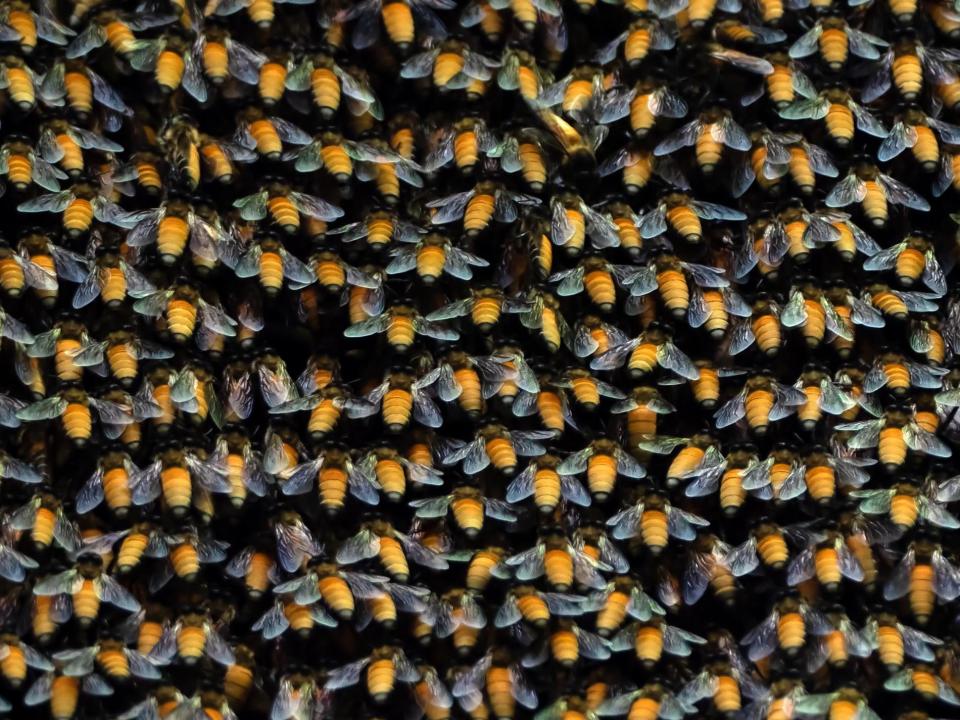Bees slower, sicker and living shorter lives because of air pollution, study suggests

Breathing toxic fumes due to exposure to heavily polluted air is one of the key contributors to early death all around the world, exacerbating risks posed by lung and heart conditions.
According to the World Health Organisation 9 out of 10 people on the planet breathe air containing high levels of pollutants resulting in around 7 million premature deaths every year.
But despite growing awareness of the risks toxic air poses to humans, almost no research has been done on the impact on the flora and fauna which are dependent on the same air we breathe.
In one of the first major efforts to try to understand the physiological impacts of air pollution on wild plants and animals, scientists from India’s National Centre for Biological Sciences in Bangalore show poor air quality could be devastating for organisms we rely on most for our own survival – pollinators such as the honey bee.
After observing declines in the giant Asian honey bee in the urban centres of Bangalore, Geetha Thimmegowda and Shannon Olson set out to understand the causes behind the falling populations of the vital pollinator.
This species of bee produces over 80 per cent of the India’s honey, and pollinates over 687 plants in the state of Karnataka alone.
Ms Thimmegowda collected and examined bees from different parts of the city under a high-powered electron microscope.
First, the scientists examined a bee from the Bangalore Life Science Cluster (BLiSC) campus on the northern and relatively low-polluted edge of the city.
This foraging bee was carrying “copious amounts of pollen on her body”, ready to pollinate new flowers.
Then they studied a bee from Peenya, an industrial area of the city, and found it was covered in small particles they later found to contain lead, tungsten, arsenic, and a host of other toxic metals.
The tiny pieces of debris, or particulate matter, less than 10 microns in size are known as Respirable Suspended Particulate Matter, or PM10, and are a major component of air pollution.
Any particles less than 10 microns in diameter are able to penetrate deep into the lungs and some can enter the bloodstream.
Particles less than 2.5 microns in diameter, also known as fine particulate matter or PM2.5, are the greatest risk to health.
The discovery of the pollution on this one bee apparently prompted a four-year study of over 1,800 wild bees, the results of which are published this week in Proceedings of the National Academy of Sciences.
The study examined the effects of air pollution on the behaviour, physiology, and molecular aspects of the giant Asian honey bee in Bangalore – one of India’s fastest growing megacities.
In collaboration with other scientists from the NCBS as well as the Institute for Stem Cell Science and Regenerative Medicine (inStem) and the The Knight Cardiovascular Institute, the scientists found that bees from more polluted areas of the city exhibited lower flower visitation rates than in less polluted areas.
Bees from more polluted areas also showed significant differences in heart rhythmicity, blood cell count, and the expression of genes coding for stress, immunity, and metabolism, the scientists said.
Repeating these experiments with lab-reared Drosophila – a species of fruit fly – found similar effects, suggesting the impact of air pollution is not species-specific, nor likely the result of other environmental factors.
Hema Somanathan, who studies bee behaviour and pollination ecology at the Behavioural and Evolutionary Ecology BEE Laboratory, at the Indian Institute of Science Education and Research, in Thiruvananthapuram, the capital of the Indian state of Kerala, said the study was “hard evidence” that not all was well with wild bee populations around cities in India.
She said: “There are extreme gaps in our knowledge on the status of our wild pollinators in India. This study by Dr Olsson and colleagues is a very important step in addressing this pressing concern.
“Bees are important pollinators in our landscapes, and this study clearly shows how pollution adversely affects the health of bees. The study was done with wild bees naturally visiting flowers in Bangalore city and not in lab assays on reared honey bees kept in hive boxes that may already be stressed or immuno-compromised. Thus, in my opinion this study provides us with hard evidence that all is not well with our wild bees.”
She added: “Given the scale of landscape alteration and urbanisation in India, it is expected that these effects are widespread and likely to worsen with time.”
The team reported that over 80 per cent of the bees collected from the moderate and highly polluted sites died within 24 hours. The air pollution levels were similar to the “Interim Target II” guidelines proposed by the WHO.
Arunabha Ghosh, founder and chief executive of Indian think-tank the Council on Energy, Environment and Water, said: “So far, much of the air quality studies in India have either considered sources of pollution or impact on human health, and to an extent on economic productivity.
“This study covers important new ground, by examining the impact of air pollution on pollinators, which would have serious implications for agricultural output in India.”
She called for greater levels of air quality monitoring, more impact studies, and also an effort to communicate the results of the research to communities.
Read more
Wildfires in Arctic release more CO2 in two months than whole of 2019
Wildflower network opens routes across UK for pollinating insects
London to build seven-mile ‘bee corridor’ to boost dwindling numbers
How urban beekeeping is killing our precious pollinators
Turn off street lights at night to help insects, scientists say
